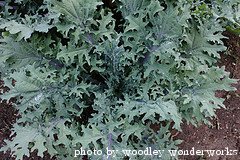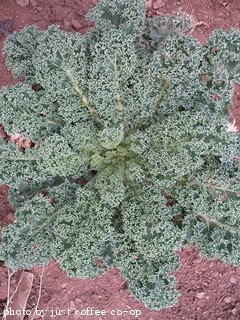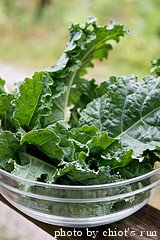Harvesting Kale
When harvesting kale, it's always better to pick the leaves a few days early rather than a few days late. Kale leaves tend to get tough and bitter if they stay on the plant too long. Don't worry, the plants will continue to grow and produce leaves as long as growing conditions are favorable. Kale is usually sweetest after the plants have been exposed to a hard freeze. Some of the best tasting kale is harvested by brushing back a few inches of snow to reveal those tender leaves.
In our own garden, we'll usually wait for a really cold night before harvesting our kale. We don't usually get much snow, but we do get below freezing weather and we do notice a big flavor improvement when the weather gets cold.
Steps for Harvesting Kale

We like to wait until plants are at least 8 inches tall before
harvesting our kale leaves, which are usually about the size of your
hand. Much smaller than this and the leaves just aren't big enough to
really mess with and you end up doing harm to the plants. Always
harvest the lowest outside leaves first and work your way up and toward
the middle. This way, you're picking the older leaves first. It's best
just to use your finger and pinch off the leaves one by one. The leaf stems are usually thin and tender enough that you don't need a knife or shears to cut them.
When harvesting kale, take as many leaves as you think you'll use. Always leave a few leaves on the plant and never cut the bud at the center of the plant, otherwise the production will stop. If you plan to use more leaves a couple of days after harvesting, go ahead and take those as well. They will store in the fridge just fine until you're ready to use them and this is usually preferable to leaving them on the plant.

If
you see any leaves that are yellow or brown, go ahead and pick those
and add them to your compost pile. The idea is to keep the plant
growing and producing new leaves as much as possible.
If the
weather is expected to get hot, you can go ahead and use a knife and cut
off the plant an inch or so above the level of the ground. This is a
quicker way to harvest a bunch of leaves fast, but you end up
sacrificing the plant in the process. This is a good option when
harvesting the last of the spring kale, before the weather gets too hot for the plants to thrive.
After harvesting kale, go ahead and rinse off the leaves. If using immediately, soak the leaves for a couple of minutes in cold water to get the grit off. Otherwise, just put it in an unsealed plastic bag with a damp paper towel and place it in the crisper drawer of your fridge. We like to keep our kale in those plastic grocery bags, but any unsealed plastic bag will work. The harvested kale will last for up to a week in the fridge. Before eating or chopping, remove the stalks and thick ribs and keep the leafy green parts.
If it's going to be more than a week when you eat the kale you harvested, you should think about freezing it. There are two main options for freezing kale - blanched and unblanched. When you blanch the kale leaves in boiling water, they will inevitably wilt and will be much more compact when they go in the freezer. This is good because you can fit a lot more kale in a lot less space in your freezer. However, the texture of the fresh kale leaves will be lost. This is fine if you're going to use the kale in soup or making a smoothie. However, if you want the kale to retain some of its fresh, crunchy texture, you should consider freezing it without blanching it. Just spread the freshly harvested kale leaves on a baking sheet and put it in the freezer. When the leaves are completely frozen, usually after 6-8 hours, you can remove them from the tray and put them in airtight plastic bags, being careful not to break up the fragile and frozen leaves. You won't be able to fit as much kale in a bag this way and it will take up a fair bit of freezer space, but it will retain a lot of its original texture when you thaw it and cook it.

Now that you've got some freshly harvested kale leaves, it's time for a few of our favorite recipes that feature kale.
Click here for some of our favorite kale recipes
Click here to move from our Harvesting Kale page to our Growing Kale main page